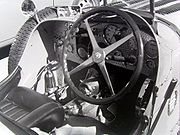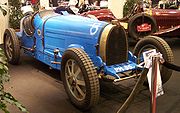
Bugatti Type 51
Encyclopedia


Bugatti Type 35
The Type 35 was the most successful of the Bugatti racing models. Its version of the Bugatti arch-shaped radiator that had evolved from the more architectural one of the Bugatti Type 13 Brescia, was to become the one that the marque is most known for though even in the ranks of the various Type 35s...
as Bugatti
Bugatti
Automobiles E. Bugatti was a French car manufacturer founded in 1909 in Molsheim, Alsace, as a manufacturer of high-performance automobiles by Italian-born Ettore Bugatti....
's premier racing car for the 1930s. Unlike the dominant Type 35s of the prior decade, the Type 51 (and later Type 53, Type 54, and Type 59) were unable to compete with the government-supported German
Germany
Germany , officially the Federal Republic of Germany , is a federal parliamentary republic in Europe. The country consists of 16 states while the capital and largest city is Berlin. Germany covers an area of 357,021 km2 and has a largely temperate seasonal climate...
and Italian
Italy
Italy , officially the Italian Republic languages]] under the European Charter for Regional or Minority Languages. In each of these, Italy's official name is as follows:;;;;;;;;), is a unitary parliamentary republic in South-Central Europe. To the north it borders France, Switzerland, Austria and...
offerings.
Type 51
The original Type 51 bowed in 1931. Its engine was a 160 hp (119 kW) twin overhead cam evolution of the supercharged 2.3 L (2262 cc/138 in³) single overhead cam straight-8Straight-8
The straight-eight engine or inline-eight engine is an eight-cylinder internal combustion engine with all eight cylinders mounted in a straight line along the crankcase...
found in the Type 35B. A victory in the 1931 French Grand Prix
French Grand Prix
The French Grand Prix was a race held as part of Fédération Internationale de l'Automobile's annual Formula One automobile racing championships....
was a rare case of success for the line. About 40 examples of the Type 51 and 51A were produced. The Type 51 is visually very similar to the Type 35 - the obvious external differences of a Type 51 are: the supercharger blow-off outlet is lower the bonnet in the louvered section; one piece cast wheels instead of bolted on rims; twin fuel caps behind the driver and finally the magneto being off-set to the left on the dash. However many Type 35 cars have been fitted with later wheels, so that isn't a reliable signal.
Type 54

Type 59
The final Bugatti race car of the 1930s was the Type 59 of 1934. It used an enlarged 3.3 L (3257 cc/198 in³) version of the straight-8Straight-8
The straight-eight engine or inline-eight engine is an eight-cylinder internal combustion engine with all eight cylinders mounted in a straight line along the crankcase...
Type 57
Bugatti Type 57
The Bugatti Type 57 and later variants was an entirely new design by Jean Bugatti, son of founder Ettore. Type 57s were built from 1934 through 1940, with a total of 710 examples produced....
's engine sitting in a modified Type 54 chassis. The engine was lowered for a better center of gravity
Center of gravity
In physics, a center of gravity of a material body is a point that may be used for a summary description of gravitational interactions. In a uniform gravitational field, the center of mass serves as the center of gravity...
, and the frame was lightened with a number of holes drilled in the chassis. The signature piano wire wheels used splines between the brake drum and rim, and relied on the radial spokes to handle cornering loads. 250 hp (186 kW) was on tap, and 6 or 7 were made.
See also
- Bugatti Type 53Bugatti Type 53The 5.0 L engine from the Bugatti Type 50 road car was fitted to the chassis of the Type 51 racer to create the 1931 Type 53. This model was historically significant in that it used four wheel drive...
- Four wheel driveFour Wheel DriveThe Four Wheel Drive Auto Company, more often known as Four Wheel Drive or just FWD, was founded in 1909 in Clintonville, Wisconsin, as the Badger Four-Wheel Drive Auto Company by Otto Zachow and William Besserdich.-History:...
Type 51 racer - Bugatti Type 57Bugatti Type 57The Bugatti Type 57 and later variants was an entirely new design by Jean Bugatti, son of founder Ettore. Type 57s were built from 1934 through 1940, with a total of 710 examples produced....
- luxury 1930s car

